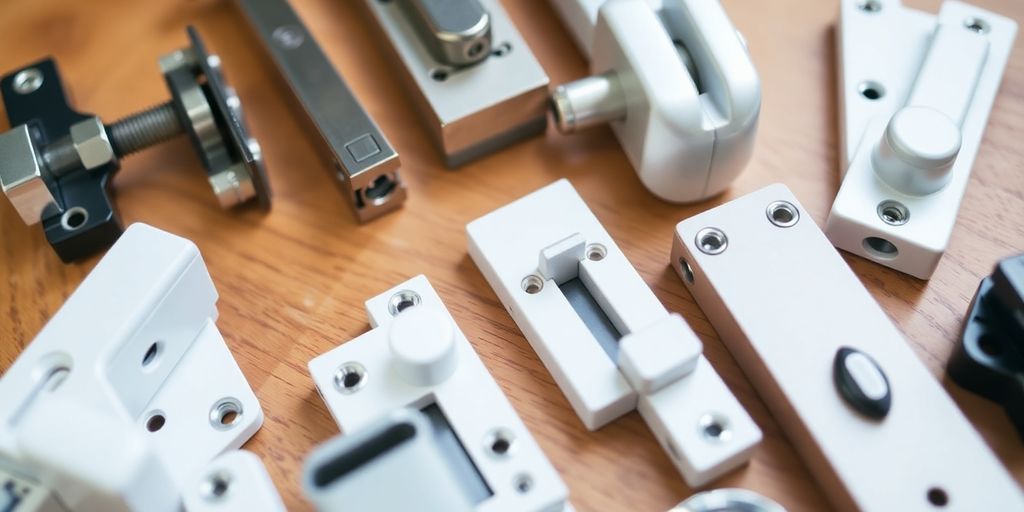
Top 5 Window Lock Options for Enhanced Home Security in 2025
When it comes to keeping your home safe, securing your windows is just as important as locking your doors. Windows can be weak points for break-ins, so having the right window lock is essential. In 2025, there are several excellent options available to enhance your home security. This article will explore the top five window lock types that can help keep your home safe and sound.
Key Takeaways
- Different window styles require specific locks to maximize security, including keyed locks, sliding window locks, casement locks, window pin locks, and multi-point locking systems.
- Child safety locks are important in homes with kids, preventing them from opening windows unsupervised and minimizing fall risks.
- Regular maintenance of window locks is key for their effectiveness—check for alignment, lubricate moving parts, and replace any damaged locks.
- Multi-point locking systems provide enhanced security by locking multiple points along the window frame, making it harder for intruders to break in.
- Choosing the right lock not only improves security but also ensures that windows can still be easily opened and closed when needed.
1. Keyed Locks
Keyed locks are a pretty common choice when you want to seriously up your home's security. They work just like your front door lock, requiring a key to open them from either side. This makes them a solid deterrent against anyone trying to jimmy a window open. I mean, who carries around a set of random keys hoping one fits?
- They offer a high level of security compared to basic latches.
- They're relatively easy to install, especially if you're replacing an existing lock.
- They provide peace of mind knowing that your windows are securely locked.
I remember when my neighbor, Sarah, had a break-in a few years back. Ever since, she's been super paranoid about security. She switched out all her window latches for keyed locks, and she says it's made a world of difference in how safe she feels. It's a simple change, but it really does add an extra layer of protection.
When picking out keyed locks, make sure to check the quality of the materials. You want something that can withstand a bit of force. Also, think about where you're putting them. If it's a window that gets a lot of weather, look for something with a weather-resistant finish. You don't want it rusting out on you after just one winter. For sliding windows, keyed locks attach directly to the window frame and require a key to unlock them, providing an excellent level of enhanced security.
2. Sliding Window Locks

Sliding windows are pretty common, especially in modern homes. They look nice and are easy to use because they slide horizontally along tracks. But, they can be a bit of a security risk if you don't lock them up properly. Someone could force them open or even lift them right off the tracks. That's why getting the right locks is super important.
Sliding window locks are designed to prevent these types of intrusions.
There are a few different kinds of locks you can use for sliding windows. Let's take a look.
Keyed Locks
Keyed locks are a solid choice for sliding windows. They attach right to the window frame, and you need a key to unlock them. This makes it way harder for someone to break in. Some brands, like Prime-Line or Defender Security, are known for making good keyed lock systems. They give you that extra peace of mind.
Track Locks
Track locks are another good option. These slide along the window track, and you can tighten them to keep the window from opening. They're easy to install and don't damage the window, so they're great if you want something simple. Plus, they're adjustable, so you can decide how far the window can open for ventilation while still keeping it secure. Track locks are a flexible solution for any homeowner.
Bar Locks and Pin Locks
Bar locks and pin locks are also worth considering. These fit into the track and limit how far the window can open. They're easy to remove if you need to open the window all the way, but they add an extra layer of security when you don't. These are especially useful for patio doors, basement windows, and ground-level windows, which are often targeted by burglars. They also help keep kids safe by stopping them from opening the window too far.
Sliding window locks are a simple and effective way to boost your home security. They're easy to install and use, and they can make a big difference in keeping your home safe from intruders. Plus, they give you extra peace of mind, knowing your windows are secure.
Here's a quick comparison of the different types of sliding window locks:
| Lock Type | Installation | Security Level | Best For |
|---|---|---|---|
| Keyed Locks | Moderate | High | Enhanced security needs |
| Track Locks | Easy | Medium | Easy installation, adjustable opening |
| Bar/Pin Locks | Easy | Medium | Limiting window opening, child safety |
3. Casement Locks
Casement windows, with their outward swing operated by a crank, present a unique security challenge. They're great for ventilation and light, but you need the right locks to stop someone from forcing them open. Casement locks are designed specifically for this type of window.
One common type is the folding lock. These locks swing down to grip the window sash tightly. You can release them by simply flipping them up. Many casement windows come with these already installed.
Casement locks are a solid choice if you live in a windy area. They keep the windows from rattling or being pushed open by strong gusts. They're also good for upper-story windows, making sure they stay shut when you're not using them.
Here's why you might consider casement locks:
- They offer a simple, effective way to secure your windows.
- They're easy to use, with a straightforward locking mechanism.
- They can be retrofitted to existing casement windows.
Another option is to use locking handles. These combine the crank with a built-in lock. This dual-function design keeps the window shut, even under pressure.
4. Window Pin Locks
Window pin locks are a simple, yet effective way to boost your home's security. They work by physically securing the window sash to the frame, making it much harder for someone to force the window open. I've found them especially useful for windows that are a bit older or in areas where I want extra peace of mind. They're not the flashiest option, but they get the job done.
- Easy to install
- Relatively inexpensive
- Provide a visual deterrent
I installed window pin locks on my basement windows last year after a string of break-ins in my neighborhood. It's a small thing, but it makes me feel a lot safer knowing there's an extra layer of protection.
These locks are particularly good for windows facing alleyways or backyards where there's less visibility. They're also a solid choice for apartment buildings, helping to prevent unauthorized openings. When selecting a window pin lock, consider the material and the length of the pin to ensure it fits your window frame properly. Installation is key, so make sure you follow the instructions carefully or get a professional to do it.
5. Multi-Point Locking Systems

Multi-point locking systems are a step up in window security. Instead of just one locking point, these systems secure the window at multiple spots along the frame. This makes it significantly harder for someone to force the window open. They're a great option if you're really serious about keeping your home safe.
Think of it like this: instead of one lock taking all the pressure, several locks share the load. This distributes any force applied during a break-in attempt, making it much tougher to compromise the window's security. Plus, they often come with features like tamper-resistant fasteners and anti-lift devices for even more protection.
Multi-point systems are especially useful for larger windows or those in vulnerable locations. They provide a higher level of resistance against forced entry compared to standard locks, giving you extra peace of mind.
Here's why you might consider them:
- Increased security: Multiple locking points make forced entry much harder.
- Enhanced durability: Distributes force, reducing stress on any single point.
- Peace of mind: Knowing your windows are extra secure can be a big relief.
These systems are a bit more of an investment, but for many homeowners, the added security is worth it. They're a good choice if you want to upgrade your home's security beyond basic window locks. You can find a Schlage lock that fits your needs.
Final Thoughts on Window Security
In the end, picking the right window locks is a big deal for keeping your home safe. With so many options out there, it’s important to think about what fits your windows best and what your security needs are. High-quality locks can really make a difference in deterring break-ins and protecting your stuff. Plus, don’t forget about the extra security measures like cameras and lights—they can really boost your home’s safety. So, take the time to choose wisely and invest in locks that will keep your home secure for years to come.
Frequently Asked Questions
What are keyed locks and why are they important?
Keyed locks require a key to open, making them harder for intruders to access. They are a strong choice for securing windows.
How do sliding window locks work?
Sliding window locks are designed to secure windows that slide open. They prevent the window from being lifted off its track.
What is a casement lock?
Casement locks are used on windows that open outward. They secure the window in place and are easy to use.
What are window pin locks?
Window pin locks attach the window to its frame, making it hard to open from the outside. They are great for added security.
What are multi-point locking systems?
Multi-point locking systems lock at several points along the window, providing extra security against break-ins.
How can I maintain my window locks?
To keep your window locks working well, check them regularly for damage, clean them, and apply lubricant when needed.
